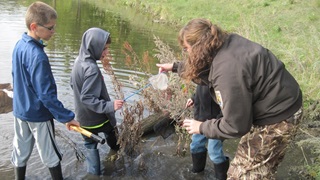Supplying the spark for a trades career
North Dakota school attracts growing numbers with satellite welding program
Last fall, it looked like the plug had been pulled on the industrial arts high school program in the town of Crosby, North Dakota.
With no shop teacher available, and no similar programs at nearby schools to join, hands-on career and technical training seemed off the table in Crosby. However, the North Valley Career and Technology Center, eight hours away in Grafton, came through with the necessary spark—stepping up to offer trades-and-technology training that was not only hands-on, but interactive.
“There are fewer and fewer instructors in rural areas and we’re getting more and more requests to help out these school districts. That’s why we started the program,” says Mike Hanson, director of the North Valley Career and Technology Center.
For the past three years, North Valley has offered telecommunications-based distance welding classes. The interactive welding program provides students real hands-on welding experience facilitated by a qualified instructor, with equipped welding classrooms in Walhalla, Crosby, Fordville and Park River. With 48 students total in Grafton and in satellite classrooms, enrollment has grown every year.
It’s also an opportunity that’s being made available to more students, with financial support from Enbridge. A recent $6,000 community investment donation, delivered in February, is earmarked for the purchase of an additional welder to be used at one of the satellite schools.
“We offer four welding classes each day through this program. This grant from Enbridge means four additional students each day have the opportunity to access a welder in class and learn these skills,” says Hanson.
Instructor Bryan Stastny has been in charge of North Valley’s welding classroom since the program began in 2012. His classes are a mix of local Grafton students and as many as 10 distance students.
Stastny uses high-definition cameras and monitors to demonstrate and supervise on the use of welding equipment. Security system cameras are installed in each location for an overall view of classroom activity, and once every nine weeks, Stastny visits the satellite schools to test the students’ knowledge face to face.
“It wouldn’t work if the students weren’t self-motivated, but they really are,” says Stastny.
Part of that motivation stems from the fact that many students can put welding skills to use almost immediately. It’s important for their family’s livelihood. “The majority of the kids have family farms and need these skills to fix broken machinery or parts on the farm,” explains Stastny.
Trades and technical career paths are commanding a growing interest, and a growing need, but rural teacher shortages and tight educational budgets make it harder to deliver, says Hanson.
“If the (satellite) welding program weren’t available, these students would really have no option,” says Hanson. “So for us, the grant from Enbridge means we get to provide more students with the opportunity to take a trades class.”










